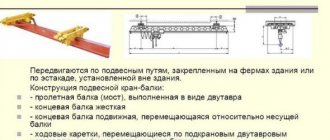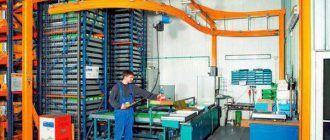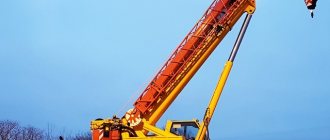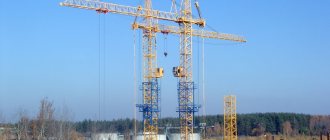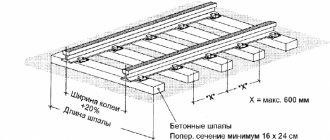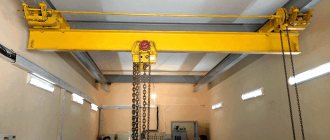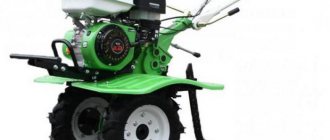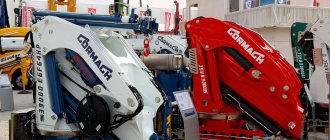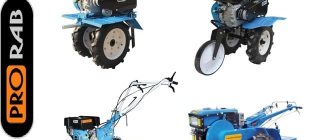Rails or foundation - that is the question!
Modern lifting cranes are a necessary component in the implementation of construction projects, but different brands and models of these machines differ significantly from each other in technical and economic indicators. The rational choice of the required type of crane during the construction of a facility is a real opportunity to reduce the cost of constructing crane tracks and foundations, reduce the labor intensity of installation and relocation of cranes, since these operations account for up to 40% of the total cost of operating a crane.
In construction practice, different options for arranging tower cranes can often be used for the construction of the same building. For example, a mid-rise building with 1–2 entrances can be erected using one free-standing crane. But it is also possible to use two less powerful free-standing cranes, which will be placed on both sides of the facility under construction. To build a high-rise building you will need at least one, and preferably two, so-called. attached cranes, which are described below. Today it is possible to construct a building of almost any configuration and height using a tower crane, which can move along installed curved crane rails. Such a crane moves along the construction site up to a certain height of the building, and then, as the number of floors increases, it “transforms” into an attachment.
Examples from the catalog
Collapsible crane KSP - 1000 "Master"
. The boom type device is installed on the ground and floors of buildings. The dismountable model allows installation without the use of equipment. Use of the device is permitted at temperatures from +40° to –40°C, humidity 80%. The diameter of the special equipment rope is 8.3 mm, the weight of the crane is 950 kg, the weight of counterweights is 700 kg. With a double reeving, the lifting speed reaches 22 m per minute, with a single reeving - 44 m per minute. The technique is used to lift, lower and transport loads around a circle.
Construction crane HGS-G200Y-30
. The technique is used to lift, lower and hold a load in a raised state. Can be used in open and closed areas. Depending on the task, the crane is used with a magnetic gripper, slings and other equipment. The crane's lifting capacity reaches up to 200 kg, lifting height is 30 m, speed is 21 m per minute. Rope length - 31 m, diameter - 4 mm.
Crane in the window “Umelets-M”
. The device is used when lifting, lowering and moving cargo weighing up to 320 kg. The design of the equipment with wheels and a boom reach of 2 m ensures ease of movement of the equipment. The working tool of the lifting mechanism is a cat with a suspension. The mass of the crane is no more than 220 kg, counterweights are no less than 210 kg. Rope diameter 4.1 mm. Lifting speed from 17.5 m to 20 m per minute.
Movement is life
Rail cranes have become widespread due to the fact that they can serve large areas of construction sites, sometimes significantly larger than the work areas served by free-standing cranes. Rail cranes do an excellent job of erecting structures during the “zero” cycle, but they are no less effective when constructing low- and mid-rise buildings. A mandatory element of the design of a rail crane is the lower frame on which the running trolleys are fixed. The main element of each running trolley is a steel running wheel.
Most ground erection cranes travel on rails laid on sleepers. Cranes, located directly on the building structures of buildings or structures, rest on rails mounted on metal or reinforced concrete beams. The designs of these supporting elements and their shape depend on the purpose and nature of the work of the structure’s frame. The choice of rail type and the design of the crane track depend on the load on the wheel, and special movement mechanisms located directly at the running wheels ensure their rotation and movement of the tower crane along the rails along the construction site. Mobility is the main advantage of a rail-mounted crane. During work at the site, emergency situations may arise, for example, the breakdown of one of the cranes, and in this case, the operation of a rail crane provides the opportunity to “maneuver” when searching for a way out of a difficult situation. In addition, the rail crane can move with a full load, which significantly reduces production losses. The design of trackless cranes does not allow for movement with loads. The disadvantages of rail-type cranes include the high cost of crane tracks and the need to install and dismantle them when relocating the cranes. The difference in the costs required to organize the operation of a rail crane and the costs of installing a similar crane on the foundation and anchor can reach 30%. However, the acquired advantages - maneuverability, stability, reduced ballast load - often justify the additional costs.
Leading manufacturers of tower cranes try to incorporate into the design of their cranes the maximum versatility of their operation. In particular, one of the largest European manufacturers of tower cranes, Liebherr, provides the possibility of various installation options in almost all models. For example, in the description of the installation of the Liebherr topless crane mod. 90 EC-B 6 indicates that it can be installed on a monolithic foundation, on a cross-shaped support; there is also the option of using it as the base of a frame with running trolleys. At the same time, the permissible speed of movement of the crane, ensured by the operation of 4 kW running motors, is up to 25 m/min.
Maximum load capacity (g/p) mod. 90 EC-B 6 – 6 t, and the boom reach reaches 50 m. The crane can lift cargo to a height of up to 51.2 m and, which is very important, move the load along rails. But the designers of the German company provided for the possibility of attaching the running wheels to the rails using special devices. In this case, the Liebherr 90 EC-B 6 with a fixed tower becomes free-standing, and if it is possible to secure the crane tower with powerful connections to the building under construction, the lifting height of the loads increases up to 100 m.
The experience of constructing cooling towers 150 m high, which are part of the Leningrad Nuclear Power Plant, is also interesting. The builders at the site used a unique Liebherr 11350 crawler crane, which lifted building structures and materials to a height of up to 196 m. The service radius of the giant, lifting a maximum load weighing 1350 tg, was 128 m!
But the use of crawler cranes, as well as pneumatic wheel cranes, when working on sites with a slope of 3–4° leads to the need for a significant, 20–30% increase in the mass of the crane’s ballast, which is expensive and not always convenient. More often, when constructing similar structures, combined crane operation is used. Until recently, crane tracks could only provide the crane with linear movement, but today technologies have been developed and used that allow the tower crane to perform curved movement. A circular rail track is laid along the base of the cooling tower, which has virtually no slope, and a tower crane moves along it, performing technological operations. At a certain point, as the height of the structure increases, a stationary tower crane is installed in the center of the facility, securing its vertical position with cables and struts, and the large reach of the boom allows the necessary cargo to be delivered to any point in the building.
Another well-known leading European manufacturer of tower cranes, the Spanish company Linden-Comansa, pays great attention to ensuring the possibility of operating its cranes in a rail version. All models of Comansa cranes can be mounted both on a stationary foundation, on anchors, and on a folding cross-shaped base, as well as as rail cranes on a cross-shaped base. The track width, depending on the height of the crane tower, can be from 3.5 to 10 m, and the speed of movement of the crane along the rails reaches 20 m/min. At the same time, due to their modular design, Comansa cranes can be transported relatively easily and economically on public roads and can be easily adapted to the requirements that arise when working on various sites.
Principle of operation
The mechanism of the water tap is based on the following:
- The valve is mounted on a vertical spindle.
- The lower part of the shaft moves inside the nut. At the end of the spindle there is a spool, which consists of a disk and a gasket, which is secured with a button or nut. The outer part is screwed into the body with a nut.
- When the tap is closed, the spindle is screwed in. The gasket falls onto the seat, blocking the fluid.
- Another barrier to water flow is the bushing at the top of the spindle. It has rubber seals that provide waterproofing.
Crane axle boxes made of ceramics have a half-turn mechanism. Ceramic plates with holes are pressed tightly, one of them is stationary. When opened, one of the plates begins to rotate, liquid enters at the moment the holes coincide. This technology is considered more reliable.
Set of water mixers.
Selecting a tower crane based on technical parameters
Cranes are selected based on the required parameters, which depend on the installation characteristics of the assembled prefabricated structural elements; Qтp — installation weight, t; Ntr—installation height, m; Lтp — installation reach, m. Since the technical characteristics of cranes for these parameters are defined in reference materials in relation to the hook, the required parameters will also be determined in relation to the hook. The required installation mass of the heaviest element (Me) is established taking into account the mounting devices and rigging attached to it (Mo): Qcrtr = Me + Mo.
Rice. 1. Scheme for determining the required characteristics for a tower crane
Legend: a - width of crane runway knees; c - the distance between the wall of the structure and the crane rail; c is the width of the structure; g - distance from the center of rotation of the crane to the end of the counterweight; Ntrkr - maximum required hook lifting height; ho is the height of the mounted part of the structure; h3 - headroom for maneuvering the element during installation; hc — suspension height; l trkr - maximum required boom radius; he is the height of the element; hп - pulley height
The installation height for tower and jib cranes is determined based on the highest mounted structure (relative to the level of the standing crane) and the height of the slinging devices.
Hktr = h0 + h3 + h hc (here h3 is taken from 0.5 to 1 m).
The mounting reach of the hook is determined by the location of the most distant element in the structure. It is defined differently for tower and jib cranes. Required mounting hook reach for tower cranes: lкtr; = a/2 + b + c- In this case (a/2 + b) must be no less than the sum of the crane overall radius (rgk) and a margin of 0.7...1 m in the lower and 0.5...1 m in the upper parts of the crane .
The required hook reach for self-propelled jib cranes, which ensures sufficient clearances between the crane boom and the mounted structures, as well as the element being lifted, is determined by the formula:
where d' and d" are the horizontal distances from the boom axis, respectively, to the mounted element and mounted structures, including the gap between them and the boom of at least 1.5 m. Required boom length:
Angle β (see figure) is practically within the range of 30...40°, and angle α is associated with the reach of the main boom. When choosing a jib, take into account that its length depends mainly on the size and location of the element being installed and the value of d.”
After determining the required parameters of the assembly cranes, they are used to select machines whose operating parameters satisfy the calculated ones, that is, they are equal to them or slightly exceed the required ones. In this case, the calculated load moment (Mgrtr = Melcr) of the most distant or heaviest element (Me) should be no more than the technical value of this characteristic for the crane.
For large volumes of installation work, the number of installation cranes jVkp and, accordingly, installation flows during the installation of the entire building are determined by the formula Ncr = Pkvsp(TpPkA), where P is the volume of installation work; kvsp - coefficient for auxiliary work: kvsp = 1.05...1.2; Тп — specified duration of work, days; PC - shifting capacity of the crane; A is the number of work shifts per day.
The final decision on the choice of installation machines is made on the basis of a technical and economic comparison of several proposed options, taking into account the technological features of use and the actual performance of these machines.
Advantages and disadvantages
The advantages of the products are simplicity, reliability, ease of repair and compatibility with domestic water supply systems. More expensive models allow you to save consumption and have the function of blocking the flow when the maximum temperature is exceeded. A number of models are convenient to install in public places for hygiene purposes thanks to the built-in sensor.
Different types of mixer designs have disadvantages. Among them: wear of the gasket, sensitivity of ceramic parts to dirty environments, the need to install a filter. Touch models are less reliable.
Crane device
Inside the housing of water faucets there is a device that blocks the flow of water. Depending on the type of design, this role is played by an expansion ring with a seal, a ball, a thermostat or a solenoid valve.
The device consists of the following elements:
- Device body.
- Supply pipes are located at the base.
- Clutch.
- Union nut.
- Pipe branch.
- To adjust the mixing of flows, a flag (cap) is provided.
- Spout. The element provides water supply. Performed in various forms.
- Seals and gaskets are necessary to prevent leaks at the joints of elements.
- Aerator. The nozzle provides water atomization and makes the stream softer.
Installation of a water tap.
Shut-off and control devices are installed in any premises where water supply is provided.
Selecting a tower crane based on basic characteristics
Read
Construction of a tower crane. Installation and dismantling of tower cranes
Of course, when choosing a crane, the consumer first of all pays attention to its basic technical characteristics, such as lifting capacity, boom lift height, boom reach, as well as parameters that follow from the basic ones: load capacity at maximum boom reach, material lifting speed , speed and range of movement of the cargo trolley, speed of rotation of the crane, height of attachment of the crane to the building under construction and energy consumption. Ease of installation and maintenance of equipment is of no small importance.
Photo source: tehnoverh.ru The flat boom is suitable for tower cranes with low and medium lifting capacity (up to 5 tons)
When choosing a tower crane, the specifics of its design are also taken into account. Thus, a flat boom or a boom made without guy cables is inferior in all characteristics to a structure equipped with a tip. The flat boom is most suitable for tower cranes with low and medium lifting capacity - up to 5 tons. For cranes with greater lifting capacity, the boom becomes too heavy and large - 3-4 meters in height at the base - and requires increased operator attention when lifting loads, since the bend of this boom in the vertical plane can be up to 3-4 meters.
The consumer also draws attention to the presence or absence of a cabin in the configuration. Tower cranes equipped with a luffing jib without a load carriage are usually very expensive, have a shorter boom and are used infrequently. When choosing between crane models equipped with a tower top and those without a top, it is necessary to take into account that the top makes installation of the crane more difficult, but the ability to raise the boom, which is not present on all cranes with a tower top, makes it possible to operate the equipment on more limited construction sites. At the same time, topless cranes are faster to install, and they are also characterized by ease and safety of work in intersecting areas.
Purpose of taps
In autonomous, local or central water supply networks, equipment is used that performs certain functions. It can serve as a control or shut-off valve. The most commonly used element for such purposes are water taps. These types of products are designed to perform different tasks. They regulate the pressure and its throughput by changing the flow area of the pipe.
There are types of water taps that, using a ball mechanism, only open or close the flow. Other devices can make adjustments. They gradually reduce the pressure. These types of water taps are more often used for homes.
Classification of cable taps
According to the degree of mobility there are:
- Fixed - their supporting elements (towers) do not move, as they are installed directly on the foundations. Therefore, all cargo operations are carried out in the working area under the rope.
- Movable - their supporting elements, one or both, move along the paths arranged for them. Their working area expands significantly and depends on the trajectory of movement.
In turn, fixed cable cranes are divided into 4 subtypes:
- Stationary – the supports are fixed as rigidly as possible. As a result, the supporting rope constantly maintains its average position, without moving anywhere during the movement of the trolley, and the working area is the narrowest.
- With tilting masts, the supports can swing laterally. When the trolley moves, the supporting rope can move at an angle of up to 6 degrees, which expands the working area.
- With a side guy - the towers are connected to the foundation using hinges, and are also equipped on both sides with winches and pulleys for guying. Thanks to this, it is possible, by tightening and releasing the pulleys, to displace the rope even more, since the swing angle of the masts reaches 8-12 degrees.
- Boathouses - several cable cranes with a common support, but separate drives and trolleys. They operate independently of each other, provide a wide service area (if properly configured), and are used mainly in shipbuilding.
Mobile cable cranes are classified into 3 subtypes:
- Parallel - both towers move synchronously along straight paths. This movement path forms a rectangular working area.
- Radial - there is a stationary tower and one (or several) moving ones - along a ring (or concentric paths). The working area with such movement trajectories is a sector.
- Circular - both towers move along concentric paths. With this movement, the working area is formed in the form of a torus.
According to the type of gripping organs, cable-type cranes are:
- with a hook (traverse) - a load is suspended on it;
- with a grab - a bucket that collects bulk or lump material;
- with a tub - it scoops up the load, and then opens up or tips over.
For maintenance of the work area there are:
- Stationary cable cranes are constantly used at one site.
- Portable – quickly installed and dismantled, easily transported from one work point to another.
According to the method of tensioning the rope, cable-type cranes are:
- with counterweight;
- with fixed mount;
- with swinging supports;
- with a descending rope.
As you can see, there are quite a lot of options, and this indirectly indicates the demand for such lifting equipment. The classification of cable ropes is very extensive, and among their variety you are sure to find a model with the required load capacity, span height and working area width.

